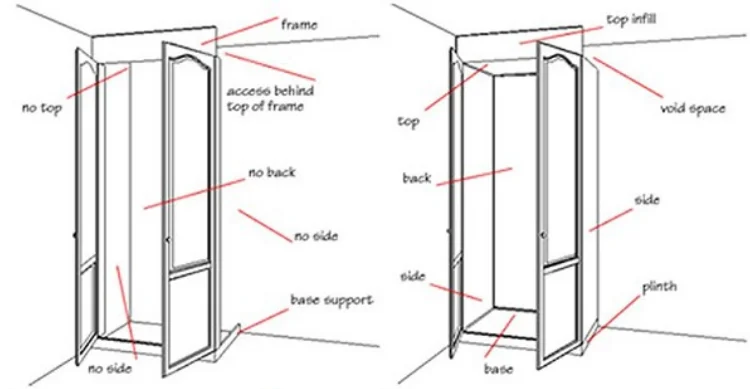
Above is a general guide for the two types of fitted furniture that is available, carcass and front frame system. Most companies will only tell you the advantages of the system they supply. With Blenheim bedrooms we will give you an unbiased opinion based on your type of room and the design you are looking, for the reason for this is unlike other companies we offer both options.
The quote about standard door sizes you can ignore as we do not have no standard door sizes, our doors are made specific to our customer requirements making us unique in the fitted bedroom industry.
Built in wardrobes ... types available
The first thing you need to ask yourself is ... which type of built in wardrobe is right for me? These are two basic types of built in wardrobes, as listed below:
- Full carcase built in wardrobes
- Frame construction built in wardrobe
Full carcase built in wardrobes
Full carcase built in wardrobes are defined as having a base, top, two sides, and a back panel. (i.e. when you open the doors you see a "fully lined" wardrobe interior).
The construction of carcase furniture is such that wardrobe's generally have "leveling features" - normally legs - under the floor of the carcase, and the doors are hinged from the side panels.
Most wardrobes are built to a height of between 2250mm and 2300mm and are designed to be filled in to the ceiling with a top scribe - filler panel - to achieve a completely fitted appearance. (Side scribing panels will also be required at the end of each run)
Frame construction built in wardrobes
Frame furniture generally has a base (or floor) but no sides or backing panel, and can be constructed from floor to ceiling at any distance from the back wall (when you open the doors you see the back and side walls - however these wall can be "lined" if required).
Depending on the manufacturer the doors are hinged either to the side of the frame, or to the front of the frame (the door then hides the hinge). The doors are generally made to two or three standard widths and heights and then fitted to form openings to the frame.
The "frame" of the built in wardrobe is generally constructed "on-site" and is scribed to adjacent walls and the ceiling ... therefore alleviating the need for top and side scribing panels.
Our conclusion ... which built in wardrobe system is best?
Anyone who attempts to convince you one built in wardrobe system is best, is at best ... missing the point!
Any built in wardrobes that fulfil your storage requirements are ultimately providing what you need, and are therefore as good as any other built in wardrobes.
However you have to make a choice at some stage ... and these points may help you decide which built in wardrobe system suits you!




